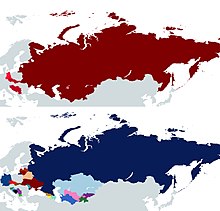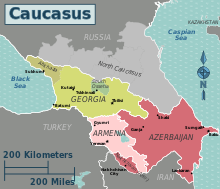| Conflict |
Parties |
Start |
End |
Detail
|
| First Nagorno-Karabakh War |
 Azerbaijan Azerbaijan
 Soviet Union (1988–91) Soviet Union (1988–91)
Supported by:
 Russia Russia |
 Republic of Artsakh Republic of Artsakh Armenia Armenia
Supported by:
 Russia Russia |
20 February 1988 |
12 May 1994 |
The separatist conflict leads to de facto independence of Republic of Artsakh (Nagorno-Karabakh Republic).
|
| South Ossetia war (1991–1992) |
 Georgia Georgia |
 South Ossetia South Ossetia
Supported by:
 Russia Russia |
5 January 1991 |
24 June 1992 |
The separatist conflict leads to South Ossetia's de facto independence from Georgia.
|
| Georgian Civil War |
 Pro-Gamsakhurdia forces Pro-Gamsakhurdia forces
Supported by:
 Chechen Republic of Ichkeria Chechen Republic of Ichkeria |
 Pro-Shevardnadze forces Pro-Shevardnadze forces  Russia Russia |
22 December 1991 |
31 December 1993 |
The Military Council deposes first President of Georgia Zviad Gamsakhurdia and asks former Soviet leader Eduard Shevardnadze to lead the country. The supporters of the ousted president stage revolt, which is crushed with the help of Russian military.
|
| War in Abkhazia (1992–1993) |
 Georgia Georgia |
 Abkhazia Abkhazia
Supported by:
 Russia Russia |
14 August 1992 |
27 September 1993 |
Abkhaz separatism leads to the de facto independence of Abkhazia from Georgia.
|
| War in Abkhazia (1998) |
 Ethnic Georgian rebels Ethnic Georgian rebels |
 Abkhazia Abkhazia |
18 May 1998 |
26 May 1998 |
Ethnic Georgians launched an insurgency against the Abkhazian secessionist government.
|
| 1998 Georgian attempted mutiny |
 Shevardnadze Government Shevardnadze Government |
 Pro-Gamsakhurdia forces Pro-Gamsakhurdia forces |
18 October 1998 |
20 October 1998 |
An abortive mutiny led by pro-Gamsakhurdia forces to remove new President Eduard Shevardnadze from power
|
| 2001 Kodori crisis |
 Georgian guerrillas Georgian guerrillas |
 Abkhazia Abkhazia |
4 October 2001 |
18 October 2001 |
Georgian guerrillas unsuccessfully try to regain control over Abkhazia with the help of Chechen fighters.
|
| Pankisi Gorge crisis |
 Georgia Georgia
Supported by:
 Russia Russia
 United States United States |
 al-Qaeda al-Qaeda Chechen rebels Chechen rebels |
2002 |
2004 |
An incursion by Al-Qaeda forces into Georgia on behalf of Chechen rebels fighting in the North Caucasus. They were forced out in 2004 by Georgian forces with American and Russian backing.
|
| 2004 South Ossetian clashes |
 Georgia Georgia |
 South Ossetia South Ossetia
 Russia Russia |
10 August 2004 |
19 August 2004 |
Clashes between Georgian and South Ossetian troops result in several deaths.
|
| 2006 Kodori crisis |
 Saakashvili Government Saakashvili Government |
 Monadire Monadire |
22 July 2006 |
28 July 2006 |
Georgian police and special forces drive a local rebellious militia out of the Georgian-controlled Kodori Valley in Abkhazia.
|
| Russo-Georgian War |
 Russia Russia South Ossetia South Ossetia Abkhazia Abkhazia |
 Georgia Georgia |
7 August 2008 |
12 August 2008 |
A war between Georgia on one side and Russia, South Ossetia and Abkhazia on the other side confirms the de facto independence of Abkhazia and South Ossetia and leads to their recognition by Russia and Nicaragua.[8]
|
| 2009 Georgian mutiny |
 Saakashvili Government Saakashvili Government |
 Mukhrovani Separate Tank Battalion Mukhrovani Separate Tank Battalion |
5 May 2009 |
5 May 2009 |
An alleged abortive mutiny by a Georgian Army tank battalion based in Mukhrovani village with a goal of removing President Saakashvili from power.
|
| 2010 Mardakert clashes |
 Azerbaijan Azerbaijan |
 Armenia Armenia Republic of Artsakh Republic of Artsakh |
18 June 2010 |
1 September 2010 |
Sporadic border war on the Armenian–Azerbaijan border and at the line of contact between the Nagorno-Karabakh and Azerbaijan.
|
| 2016 Nagorno-Karabakh conflict |
 Azerbaijan Azerbaijan |
 Armenia Armenia Republic of Artsakh Republic of Artsakh |
1 April 2016 |
5 April 2016 |
Armenian and Azerbaijani forces fight a four-day long conflict along the border of the unrecognized Republic of Artsakh. Azerbaijani forces make minor territorial gains, some of which are retaken by Armenian forces before the end of the conflict.
|
| July 2020 Armenian–Azerbaijani clashes |
 Azerbaijan Azerbaijan |
 Armenia Armenia |
12 July 2020 |
16 July 2020 |
Armenian and Azerbaijani forces engage in border clashes along the Tavush Province of Armenia and Tovuz District of Azerbaijan. The death of Azerbaijani major general Polad Hashimov sparks the July 2020 Azerbaijani protests. Turkey and Azerbaijan organize large-scale military exercises following the clashes, and tensions persist until the beginning of the Second Nagorno-Karabakh War 2 months later.
|
| Second Nagorno-Karabakh War |
 Azerbaijan Azerbaijan
Supported by:
 Turkey Turkey
 Israel Israel |
 Armenia Armenia Republic of Artsakh Republic of Artsakh |
27 September 2020 |
10 November 2020 |
Azerbaijan retakes most of the territories previously controlled by the Republic of Artsakh. Russian peacekeepers introduced into the remaining disputed area.
|
| Armenia–Azerbaijan border crisis |
 Azerbaijan Azerbaijan
Supported by:
 Turkey Turkey |
 Armenia Armenia |
12 May 2021 |
present |
Border clashes between Azerbaijan and Armenia.
|
| Blockade of Nagorno-Karabakh |
 Azerbaijan Azerbaijan |
 Republic of Artsakh Republic of Artsakh |
12 December 2022 |
October 2023 |
Azerbaijan blockades the Republic of Artsakh.
|
| 2023 Azerbaijani offensive in Nagorno-Karabakh |
 Azerbaijan Azerbaijan |
 Republic of Artsakh Republic of Artsakh |
19 September 2023 |
20 September 2023 |
Azerbaijan launches an attack on the Republic of Artsakh after nine months of blockade. The Artsakh Defence Army disbands, the government of the Republic of Artsakh agrees to dissolve itself entirely by January 1, 2024, and almost the entire population of Artsakh flees to Armenia.
|


